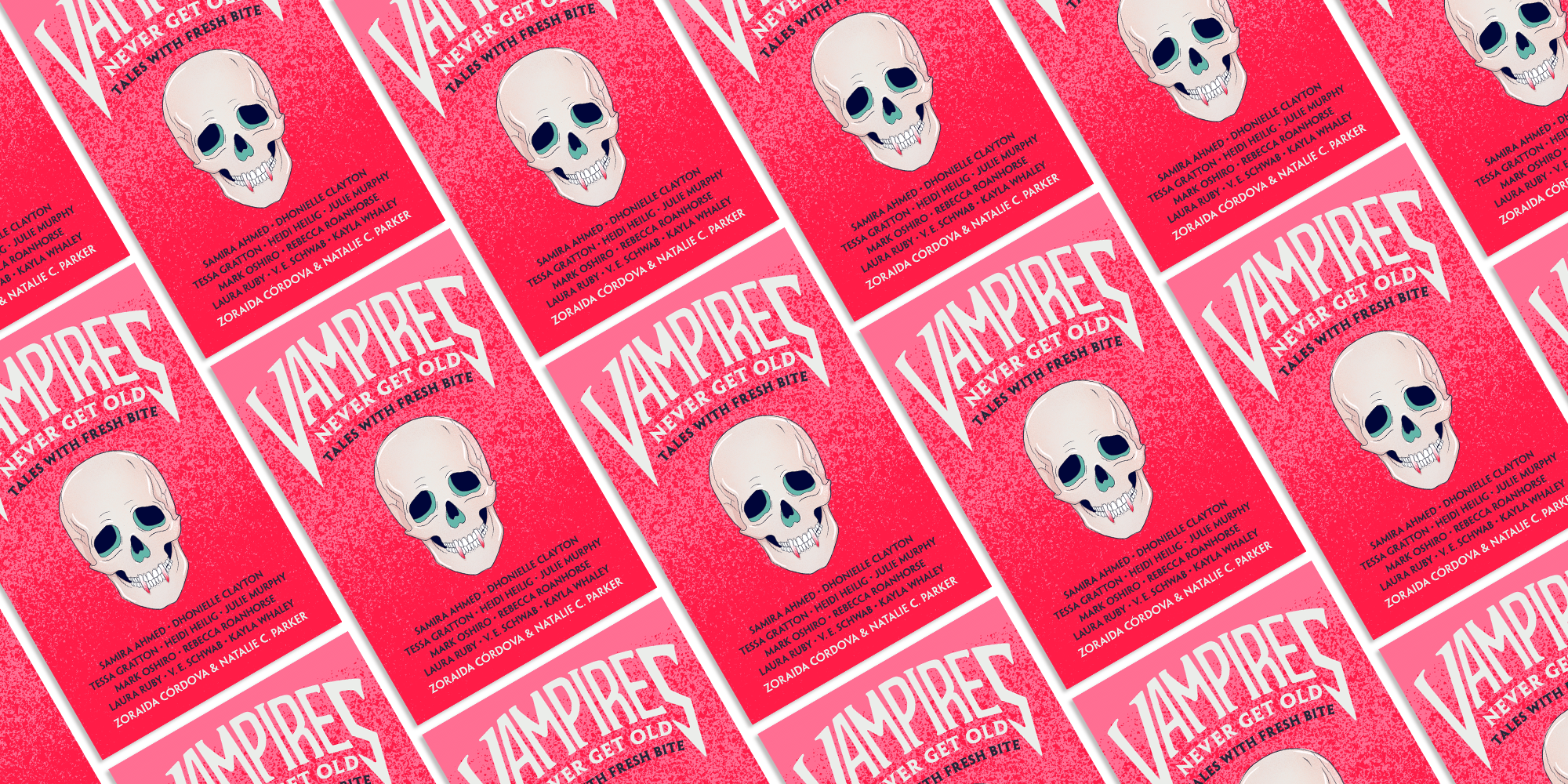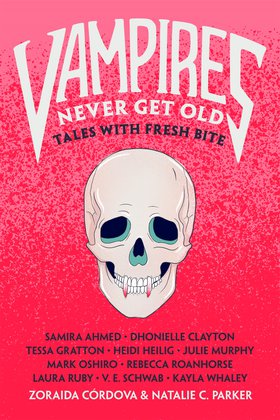Vampire Never Get Old Authors Talk Favorite Vampires
September 17, 2020 | 8:00 AM
Vampire Never Get Old Authors Talk Favorite Vampires
By Vampires Never Get Old Contributors
Of all the monsters we’ve met in fiction and folklore, vampires occupy a unique space. They are at once monstrous and alluring, simultaneously inhuman and achingly, brilliantly more human than anything else. More than any other mythical creature they move elegantly between genres from horror to satire to prime-time teen drama. Yet, for all their narrative flexibility, the stories told again and again place a familiar kind of vampire at the center. You know him. He’s white, cisgender, hetero, able-bodied, and very likely committed to brooding away the midnight hours.
When we sat down to create this anthology our goal was to give authors an opportunity to begin weaving new stories, to explore the vampire myth using different starting points, to twist and turn and reshape the way these narratives unfold. And we weren’t disappointed. In anticipation of sharing this full collection with you, we’ve asked our contributors to tell us a little about their own vampire touchstones. We hope you enjoy this trip down vampire lane!
Samira Ahmed: In Buffy the Vampire Slayer, Spike was moody, sarcastic, and peroxided. Those were his good points. But in his own words, he was also a monster. He’s the ultimate problematic fave with the most fulfilling arc of any character in the Buffyverse. Spike was horrible, but he challenged his vampire nature. Showed what it meant to have agency even when your choices are stolen. Maybe it was all that bad poetry he wrote, but even without a soul, Spike could be soulful—reaching for remnants of his humanity. Trying and failing, searching for redemption knowing he might never be redeemed. Spike was no hero, but for a shining moment, he was a champion.
Dhonielle Clayton: My love affair with vampires started before I could fully talk. Count von Count from Sesame Street was the first vampire I met. The first vampire I loved. He taught me all the important things—like an appreciation of numbers and how to sing them. He also made me fascinated with bats, cobweb-infested castles, monocles, his cat Fatatita, the Carpathian Mountains and Romania, the tiny thunder with lightning that followed him around, and hunter green capes. His organ songs became the soundtrack of my little dreams and his main jam “Batty Bat” is one I’ll never forget. My mother said I annoyed her to no end shouting: “1-2-3 count, Batty Bat, Batty Bat, Batty Bat” all day, a refrain that I probably thought might bring him to my windowsill. Refresh yourselves—the best and most badass vampire there ever was.
Zoraida Córdova: Damon Salvatore is the slow-burn romance I want. From the moment I saw him, I hated him. I was fully #TeamStephan. Damon was too pretty, too brash, and completely wrong for Elena. Damon is your basic instinct and instant gratification come to life. That can be absolutely terrifying . . . Or thrilling. My favorite part about vampire myth is the release from humanity. But it’s in that release, that freedom, that you learn to confront your humanity.
Tessa Gratton: I love Gilda in The Gilda Stories by Jewelle Gomez because not only was it the first vampire book I read that agreed with me about all vampires being queer, Gilda is a living embodiment of vampirism as a form of political and spiritual connection. Gilda was born into slavery and generational trauma in America and frees herself again and again by making connections with human women and building a queer, mostly BIPOC family of vampires. The book re-centers vampire mythology around the lives of deeply marginalized Americans, reinventing the tropes to emphasize through the dramatic, sexy, 200-year story how Black women loving one another and doing the hard work of staying hopeful and proud in the face of white capitalism and looking toward a future where chosen family and being grounded in shared humanity is the purpose of living.
Heidi Heilig: I love a good reveal—the lips curving back to expose the long teeth, the eyes of the corpse opening suddenly in the coffin. So of course I met my favorite vampire in an unexpected setting: an epic poem, where a sailor becalmed on the slimy sea was cursed with life-in-death for the crime of shooting an albatross. “The Rime of the Ancient Mariner,” published ninety-nine years before Dracula, may seem an unlikely vampire story, but the titular character describes experiences very much in line with popular ideas of vampirism, including inability to wear a cross, the drinking of blood, and the dead rising. Vampires never get old—but in Samuel Taylor Coleridge’s famous poem, they do get ancient.
Julie Murphy: So many vamps to choose from, but I always come back to my problematic fave, Edward Cullen. Twilight hit me at a time in my life when I needed it the most. I was falling back in love with reading, and even considering writing for the first time. Twilight made writing feel accessible to me. It was also a very difficult time in my personal life and I’ll always be thankful that I had that book to get lost in. Twilight, and specifically Edward, also spoke to some of my own teenage fantasies that were somewhat problematic, but also really difficult to verbalize. Besides, the thing really missing from our vampire lore was a little bit of sparkle.
Mark Oshiro: I didn’t grow up consuming much vampire fiction, but I loved the Blade films. There was something so compelling to me about a vampire fighting against his own kind while struggling with his own humanity—or loss of it. It’s the same reason why, as an adult, I came to enjoy the character of Angel from Buffy the Vampire Slayer and Angel. His character was most interesting when it was exploring the complicated morality of being a vampire. I looked to both Blade and Angel as influences when constructing my strange teenage vampire.
Natalie C. Parker: Caroline Forbes of The Vampire Diaries is a stereotype. She's the ditzy blonde girl full of bubbles and sunshine; the school gossip; the Queen Bee. As a stereotype she is a villain in her own right. She’s the mean girl, vapid, vindictive, and vampiric in a wholly human way. But as a vampire Caroline challenges those ideas on every level. When Caroline transforms, all the parts of her that bump against sexist stereotypes of teenage girls become the things that make her powerful as a vampire. I adore Caroline because she shows us that sometimes monsters are the most human of us all.
Rebecca Roanhorse: I discovered Jean-Claude from the Anita Blake series in college. He was everything I love about the vampire mythos. He was mysterious, had a tortured and bloody past, could be ruthless, and was so, so sexy. That mix of violence, darkness, and vulnerability makes him a great foil for the heroine, who knows she should kill him but just can’t bring herself to do it, and instead falls in love, a trope I adore to this day. I guess some of us always fall for the bad boys with a heart of gold, even if that heart doesn’t beat.
Laura Ruby: I picked A Girl Walks Home Alone at Night because it’s a mash-up of many genres including horror and westerns, because there’s a cat (there must always be a cat), and because of the witty way writer/director Ana Lily Amirpour plays with vampire iconography, trading the tired vision of the caped and brooding sexy male vampire, into a chador-wearing, skateboarding, vengeful yet vulnerable young monster girl, a girl who wields her enormous power against abusers. Add to this a love interest who is attracted to this mysterious girl’s power, and you have the perfect vampire picture—smart, scary, and feminist.
Victoria “V. E.” Schwab: Vampires are known for two things: insatiable hunger, and existential angst. Two elements in constant counterbalance: desire and guilt, longing and self-loathing, physical needs and psychological repercussions. Anne Rice’s Louis is an embodiment of these contradictions, but I always found Lestat’s abandon, his defiant joie de vivre more refreshing.
Kayla Whaley: Interview with the Vampire’s Claudia is powerful, ruthless, unapologetic. She kills gleefully. She’s a master manipulator. She unnerves as easily as she entrances. And she’s doomed to be perceived forever as a child. In thirty years of disabled life, I can't remember ever being in public without being infantilized. I, too, am forever perceived as a child. So Claudia resonated with me in a rare, visceral way, and I can finally articulate why. (Important note: In some cases, Claudia’s reality—forced into an un-aging child’s body—translates literally, not just metaphorically. Search for: “Ashley’s Treatment” or “growth-attenuation therapy.”)

Vampires Never Get Old edited by Zoraida Córdova and Natalie C. Parker
In this delicious new collection, you’ll find stories about lurking vampires of social media, rebellious vampires hungry for more than just blood, eager vampires coming out—and going out for their first kill—and other bold, breathtaking, dangerous, dreamy, eerie, iconic, powerful creatures of the night.
Welcome to the evolution of the vampire—and a revolution on the page.
Vampires Never Get Old includes stories by authors both bestselling and acclaimed, including Samira Ahmed, Dhonielle Clayton, Zoraida Córdova and Natalie C. Parker, Tessa Gratton, Heidi Heilig, Julie Murphy, Mark Oshiro, Rebecca Roanhorse, Laura Ruby, Victoria “V. E.” Schwab, and Kayla Whaley.




